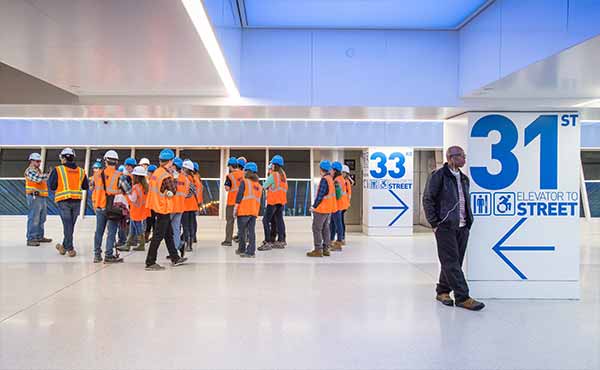
Moynihan Station
This is a city where the smallest business can define a block. Favorite eateries shutter, only to reopen and become new favorite boutiques. On any given day massive structures take new shape.
“A city is constantly changing,” says Westerink. “Especially big cities. All cities are constantly evolving. If you stay in one city your entire life, it’s a different city by the time you die. Look at Manhattan. It was a big port city for years. Now it’s a big business city. It’s very different today than even 50 years ago.”
Engineering is not just a matter of building but of rebuilding — taking into account the history of a place and staying true to that history while creating something new.
“My favorite site we visited was the post office, which was being renovated into a train station. That is something new that I didn’t realize civil engineers were involved in. The engineering firm was tasked to give new purpose to an existing architectural landmark.” – Andrew Hellman
Built in 1912, the James A. Farley Building, the former General Post Office was once central to America’s correspondence. Much of the country’s mail passed through the building. Above a dramatic row of columns, reads the phrase, “Neither snow nor rain nor heat nor gloom of night stays these couriers from the swift completion of their appointed rounds.”
A lot has changed since those words were etched into the structure’s stone crown.
Today, the Farley building is under construction, part of a $2.5 billion transformation project that will turn it into the Moynihan Train Hall, a much-needed extension of another New York City landmark — Penn Station.
The building will serve as a new concourse with 700,000 square feet of commercial, retail and dining space.
The project is still a work in progress. The center of the building has been hollowed out, though a portion of the historical post office will be kept as is and will remain fully functional.


“It was incredible to see that engineers can take something historic and out-of-commission, like the Farley Post Office, and transform it into something completely necessary and state-of-the-art, like the brand-new Penn Station,” says Elizabeth Greason.
The current Penn Station serves a reported 650,000 passengers each day — and that is 450,000 more than it was originally designed for in the 1960s. “City leaders envisioned using the Farley Post Office, adjacent to the overcrowded Penn Station, and transforming it into a mixed-use facility, including an iconic train hall with the turn-of-the-century grandeur of the original Penn Station,” Westerink says.

Heavy demolition has begun, but the site is still early on in construction. The project is slated to be finished in 2020.
Here, students get a lesson in vision. What looks to the casual visitor like an abandoned hall with complex support systems throughout is the stage for what will be an internal courtyard, a glass atrium — a place both historic and of the modern age. And a beautiful way to enter or exit the city.